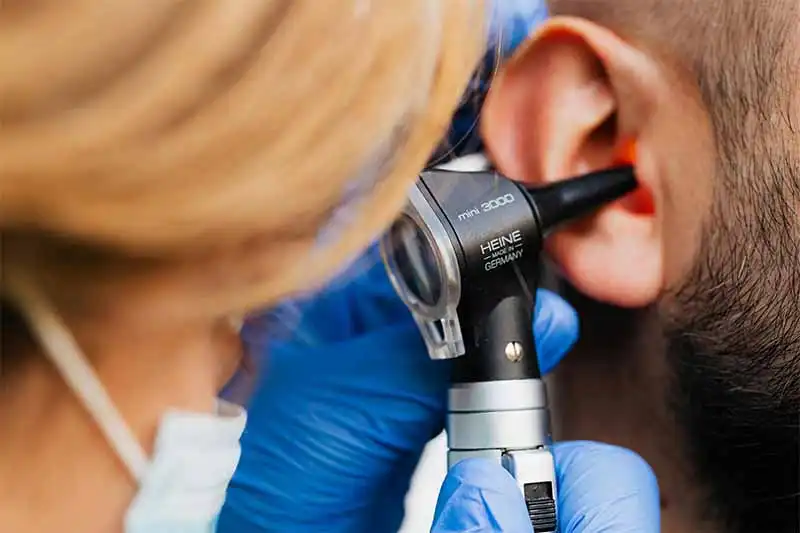Google Ads for ENT Specialists: Attract More Patients & Boost Your Practice
As an ENT specialist, your focus is on helping patients with ear, nose, and throat conditions.
But in today’s digital world, simply having a clinic or a medical degree isn’t enough to attract new patients.
People are turning to Google to find the best healthcare providers near them, searching for terms like “ENT doctor near me” or “sinus specialist in [city]” when they need immediate care.
This is where Google Ads becomes an essential tool for your practice.
Why Digital Marketing is Crucial for Medical Professionals
The way patients find healthcare providers has changed drastically.
While word-of-mouth referrals and traditional advertising (like print ads or billboards) still exist, they are no longer the most effective way to attract new patients.
Most people now rely on online searches to compare doctors, read reviews, and book appointments.
If your practice isn’t showing up at the top of search results, you’re missing out on a significant number of potential patients.
Unlike SEO, which takes time to rank your website organically, Google Ads gives you instant visibility at the top of search results.
When someone types in a search like “best otolaryngologist for allergies”, a well-optimized Google Ads campaign ensures your clinic appears right away, increasing your chances of getting that patient to book an appointment.
How Google Ads Helps ENT Specialists Attract More Patients
Google Ads is a pay-per-click (PPC) advertising platform, meaning you only pay when someone clicks on your ad.
This makes it a cost-effective strategy because you’re investing directly in potential patients who are actively searching for ENT services.
One of the biggest advantages of Google Ads is its ability to target high-intent users—people who aren’t just browsing but are actually looking for an ENT specialist.
By using location-based targeting, you can ensure your ads appear only to people in your service area, avoiding wasted ad spend on people who are too far away to visit your clinic.
Another benefit is the ability to customize your ads based on patient needs.
For example, if you specialize in hearing loss treatment, you can create ad campaigns specifically targeting searches like “best ENT for hearing loss”, ensuring your message reaches the right audience.
Challenges ENT Specialists Face in Attracting New Patients
Despite having the medical expertise, many ENT specialists struggle with standing out in a competitive market.
Larger hospitals and multi-specialty clinics often dominate search results, making it harder for independent specialists to gain visibility.
Without a strong online presence, even the most experienced doctors may struggle to attract a steady flow of patients.
Another common challenge is ensuring that ad spend leads to actual patient appointments.
Many ENT clinics run ads without optimizing their landing pages, leading to potential patients clicking the ad but not booking an appointment.
A well-structured Google Ads campaign combined with an easy-to-navigate appointment booking page can significantly improve conversion rates.
For ENT specialists looking to grow their practice, Google Ads is not just an option—it’s a necessity.
It provides immediate visibility, reaches the right audience at the right time, and ensures your clinic stands out in a highly competitive space.
By leveraging targeted keywords, optimizing your ad campaigns, and providing a seamless booking experience, you can effectively turn online searches into new patient appointments.
What are Google Ads and How Do They Work?
Google Ads is an online advertising platform that allows businesses—including healthcare providers like ENT specialists—to appear at the top of Google search results when potential patients look for services.
It operates on a pay-per-click (PPC) model, meaning you only pay when someone clicks on your ad.
This makes it a cost-effective way to attract high-intent patients who are actively searching for an ENT doctor.
For example, if someone types “ear infection specialist near me”, a well-targeted Google Ads campaign can ensure your clinic appears above organic search results, giving you instant visibility.
Unlike traditional advertising, where you pay upfront without knowing if people will actually see your ad, Google Ads lets you control your budget while focusing on users who are most likely to book an appointment.
Different Types of Google Ads and Their Placements
Google Ads offers different ad placements, each serving a unique purpose. While all can be beneficial, not every format is the right fit for an ENT specialist.
Search Ads
These are text-based ads that appear at the top of Google Search Results when users type in specific queries like “best ENT doctor for sinus problems” or “otolaryngologist near me”.
These ads are highly effective because they target users actively looking for medical care, making them the best choice for patient acquisition.
Display Ads
These are visual banner ads that appear on various websites across Google’s Display Network.
They help build brand awareness but are less effective for directly driving appointment bookings because they target users who may not be actively searching for an ENT specialist at that moment.
Local Services Ads (LSAs)
These are designed specifically for local businesses, including healthcare providers.
When available in your region, LSAs place your clinic at the very top of Google Search with a “Google Screened” badge, which increases trust and encourages direct phone calls or appointment requests.
Unlike traditional Google Ads, LSAs operate on a pay-per-lead basis, meaning you only pay when someone contacts your clinic.
Why Search Ads Are the Best Fit for ENT Specialists
For an ENT specialist, the goal is to reach patients exactly when they need medical attention.
Unlike display ads, which rely on passive visibility, search ads target users with immediate intent, ensuring that your clinic is seen by people actively searching for treatment.
Moreover, Google Search Ads allow precise targeting, enabling you to refine your audience based on factors like location, search terms, and even device type.
If your clinic is in New York, you can ensure your ads only appear to users searching for “ENT doctor in New York”, preventing wasted ad spend on people outside your service area.
Another major advantage of search ads is the ability to track and optimize performance.
With built-in conversion tracking, you can measure how many people clicked on your ad, filled out an appointment form, or called your clinic—allowing you to adjust your strategy for better results.
Google Ads offers a powerful way for ENT specialists to grow their patient base, but choosing the right ad type is crucial.
Search Ads provide the most effective way to attract patients with immediate medical needs, ensuring that your clinic appears at the top of search results when people are looking for your services.
By combining precise targeting, budget control, and performance tracking, you can maximize your ad spend and bring more patients through your doors.
Why Should ENT Specialists Use Google Ads?
If you’re an ENT specialist looking to attract more patients, relying solely on word-of-mouth referrals or organic search rankings may not be enough.
When people need immediate medical attention for ear, nose, or throat issues, they turn to Google with high-intent searches like “best ENT doctor near me” or “sinus infection specialist in [city]”.
Google Ads ensures that your clinic appears at the very top of search results, increasing your chances of getting new patients.
Reaching Local Patients When They Need You Most
Unlike traditional advertising methods, where your message reaches a broad audience regardless of their needs, Google Ads allows you to target potential patients based on their search behavior, location, and intent.
This means your ads are shown only to people in your area actively searching for an ENT specialist, making it one of the most efficient ways to acquire new patients.
For example, if your clinic is in Los Angeles, you don’t want to waste money showing ads to people in New York.
With geo-targeting, Google Ads ensures your practice is visible only to users within your service area, increasing your chances of appointment bookings while reducing unnecessary ad spend.
Google Ads vs. SEO: Organic vs. Paid Reach
Many ENT specialists wonder whether they should focus on SEO (search engine optimization) or invest in Google Ads.
While both strategies are valuable, they serve different purposes.
Search Engine Optimization (SEO)
SEO is great for long-term visibility, helping your website appear in organic search results when people look for ENT-related topics.
However, SEO takes time—sometimes months—to generate significant traffic, and ranking on the first page isn’t guaranteed, especially in competitive locations.
Google Ads
Google Ads, on the other hand, provides instant visibility.
The moment you launch a campaign, your practice can appear at the top of search results for targeted keywords, ensuring you get immediate patient inquiries rather than waiting months for organic rankings to improve.
Other digital marketing channels, like social media or email marketing, are useful for brand awareness and patient retention but don’t directly target users in the decision-making stage.
Someone scrolling through Facebook may not be looking for an ENT doctor, but someone searching for “ENT specialist for allergies near me” on Google is much more likely to book an appointment.
Maximizing ROI with a Focused Approach
Since Google Ads operates on a pay-per-click (PPC) model, you only pay when someone actually clicks your ad.
This ensures that your budget is spent efficiently, targeting people who are already interested in ENT services.
Additionally, by refining your ad copy, keywords, and landing page experience, you can optimize your campaigns for maximum patient conversions.
Google Ads is a game-changer for ENT specialists looking to grow their practice.
It allows you to instantly reach local patients, appear for high-intent search queries, and compete with larger medical groups without waiting for SEO results.
When combined with a well-optimized landing page and conversion strategy, Google Ads can become a powerful patient acquisition tool, ensuring your clinic stays ahead of the competition.
Setting Up a Successful Google Ads Campaign
Creating a well-structured Google Ads campaign for ENT specialists requires more than just setting up an ad and hoping patients will click.
To effectively attract local patients, you need to choose the right campaign type, optimize your budget, and ensure your ads are reaching the right audience.
Let’s break down the key steps to setting up a high-converting ad campaign for your practice.
Choosing the Right Campaign Objective & Type
Google Ads offers multiple campaign types, but not all of them are suitable for medical professionals.
ENT specialists should focus on campaign types that drive patient inquiries and appointment bookings rather than just increasing brand awareness.
Search Campaigns
These text-based ads appear when users search for specific keywords like “ENT doctor near me” or “ear infection treatment specialist.”
Since these users are actively looking for medical services, Search Ads are the most effective for immediate patient acquisition.
Display Campaigns
These visual ads appear on websites across Google’s Display Network.
While useful for brand awareness, they are less effective for direct patient conversions because they target a broader audience that may not be actively searching for ENT services.
Performance Max Campaigns
These fully automated campaigns run across multiple Google platforms (Search, Display, YouTube, and Gmail).
They can be beneficial for expanding your reach but require strong audience signals and conversion tracking to ensure your budget is spent efficiently.
For most ENT practices, Search Ads with local targeting will provide the highest return on investment (ROI) by directly capturing users searching for your services.
Configuring Campaign Settings
Once you’ve selected the right campaign type, optimizing the settings is crucial to ensure your budget is used efficiently.
Budgeting & Bid Strategies
Google Ads allows you to control how much you spend daily. If you’re new to Google Ads for ENT specialists, start with a manageable budget (e.g., $10–$50 per day) and adjust based on results.
For bidding strategies, you can choose:
- Maximize Clicks – Good for beginners who want to generate as much traffic as possible within their budget.
- Target CPA (Cost-Per-Acquisition) – More advanced and ideal if you want to optimize for actual appointment bookings rather than just clicks.
Ad Scheduling
Running ads at the right time can improve your conversion rates.
Since most patients search for doctors during business hours, consider scheduling your ads to run from morning until early evening and pausing them during late-night hours when inquiries are less likely.
Location and Language Targeting
Geo-targeting is essential for local medical practices.
There’s no point in showing your ads to users outside your service area because they’re unlikely to travel long distances for an appointment.
Setting Up Local Targeting
Google Ads allows you to define your service area by country, city, or even specific zip codes.
A good strategy is to use radius-based targeting, setting your ads to appear within a 5-10 mile radius of your clinic to attract patients in your immediate vicinity.
Exclusions
If there are areas where you don’t want to show ads (e.g., locations where you don’t have a strong patient base or competing hospitals), you can exclude those zip codes or regions to prevent wasted ad spend.
Additionally, ensure that your language settings match your target audience. If your clinic primarily serves English-speaking patients, avoid running ads in multiple languages unless necessary.
Audience Segments & Targeting
Beyond just targeting based on location, you can refine your ads using Google’s audience targeting options to reach the most relevant users.
In-Market Audiences
Google identifies users actively looking for healthcare services, including those searching for ENT treatments.
Targeting these audiences increases your chances of reaching people ready to book an appointment.
Custom Intent Audiences
You can create custom audiences based on specific keywords users have searched for, such as “sinus specialist near me” or “treatment for ear infections.”
This allows you to reach potential patients before they even land on your website.
Retargeting for Unconverted Visitors
Not everyone who clicks on your ad will book an appointment immediately.
By enabling remarketing, you can re-engage users who previously visited your website but didn’t schedule a consultation.
Retargeting ads can remind them of your services and encourage them to take action.
A well-structured Google Ads campaign for ENT specialists ensures you are maximizing patient inquiries while keeping your ad spend under control.
By choosing the right campaign type, refining your location targeting, and leveraging audience segmentation, you can create an ad strategy that effectively drives appointment bookings.
Understanding Google Ads Account Structure
A well-structured Google Ads account is essential for ENT specialists to run effective campaigns that attract the right patients.
Without proper organization, ads may target irrelevant search queries, leading to wasted ad spend and fewer appointment bookings.
Google Ads uses a hierarchical structure consisting of campaigns, ad groups, and keywords.
Campaigns define the overall goal and targeting, ad groups categorize different services, and keywords determine which search queries trigger your ads.
Structuring your account correctly ensures higher ad relevance, better Quality Scores, and ultimately, lower costs per click (CPC).
What are Ad Groups and How to Structure Them?
Ad groups are the foundation of your campaign’s organization.
They allow you to group related keywords and ads under a single theme, ensuring that when a patient searches for a specific condition or treatment, they see the most relevant ad.
For ENT specialists, a well-structured campaign should have separate ad groups for different services.
Instead of lumping all keywords into one ad group, segmenting them improves ad relevance and leads to higher conversion rates.
Example of Ad Group Segmentation for ENT Specialists:
- Sinus Treatment – Keywords like “sinus specialist near me,” “sinus infection doctor,” “chronic sinusitis treatment.”
- Hearing Loss & Audiology – Keywords like “ENT doctor for hearing loss,” “best audiologist near me,” “hearing test specialist.”
- Allergy Treatments – Keywords like “ENT doctor for allergies,” “allergic rhinitis specialist,” “treatment for nasal allergies.”
- Ear Infections – Keywords like “ear infection treatment,” “ear pain doctor near me,” “ENT for ear infections.”
Each ad group should contain:
- Targeted keywords (closely related to the service).
- Tailored ad copy (mentioning the specific condition or treatment).
- A dedicated landing page (that matches the search intent).
By structuring ad groups this way, you increase the likelihood that patients searching for ENT services see an ad directly related to their condition, making them more likely to book an appointment.
Selecting the Right Keywords for ENT Specialists
Keywords determine when your Google Ads appear in search results.
Choosing the right high-intent keywords ensures your ads are shown to potential patients actively looking for an ENT specialist.
Primary vs. Secondary Keywords
- Primary keywords – These are the main search terms potential patients use when looking for an ENT specialist, such as “ENT doctor near me,” “best ENT specialist,” or “ear, nose, and throat doctor.”
- Secondary keywords – These support the primary keywords and provide additional context. Examples include “sinus infection treatment,” “hearing loss specialist,” or “nasal congestion relief.”
High-Intent Keywords for ENT Specialists
Patients searching with these high-intent phrases are more likely to book an appointment:
- “ENT doctor near me”
- “best ENT specialist for sinus infections”
- “ear pain treatment specialist”
- “hearing loss treatment in [city]”
- “ENT doctor for allergies”
- “sinus surgery specialist near me”
Using a mix of primary and secondary keywords helps increase ad visibility and ensures you capture both general ENT searches and condition-specific searches.
Keyword Match Types & How to Use Them
Google Ads offers three main keyword match types that control when your ads appear based on a user’s search query.
Understanding how to use them effectively helps you avoid irrelevant clicks and improve your campaign’s efficiency.
Broad Match (Least Recommended for ENT Ads)
Shows ads for related searches, even if the phrase is not an exact match.
- Example: If you target “sinus infection doctor,” your ad might show for “cold remedies” or “home treatment for congestion.”
- Risk: Can lead to wasted ad spend on irrelevant traffic.
- Best Practice: Use broad match only if combined with negative keywords to filter out unrelated searches.
Phrase Match (Recommended for Most ENT Keywords)
Ads appear for close variations of the keyword while keeping the core meaning intact.
- Example: “ENT doctor near me” might trigger searches like “best ENT doctor near me” or “ENT doctor for sinus issues near me.”
- Best Practice: Helps capture high-intent searches while avoiding irrelevant ones.
Exact Match (Best for Highly Specific Searches)
Ads appear only when users search for the exact phrase or close variants.
- Example: Targeting [ear infection doctor near me] will trigger searches like “ear infection doctor near me,” but not “ear pain remedies.”
- Best Practice: Ideal for high-converting searches that indicate strong intent to book an appointment.
Avoiding Irrelevant Clicks with Negative Keywords
To prevent wasting ad spend, add negative keywords that exclude searches unlikely to convert.
For example:
- “home remedies for sinus infection”
- “ENT doctor salary”
- “free ENT consultation”
By refining keyword match types and negative keywords, you ensure your ads appear only to potential patients searching for ENT services.
A well-structured Google Ads account for ENT specialists makes a significant difference in campaign performance.
Properly organizing ad groups, selecting the right keywords, and using match types strategically ensures your ads reach the right patients at the right time.
Crafting High-Performing Google Ads
Creating effective Google Ads for ENT specialists isn’t just about showing up in search results—it’s about capturing attention, building trust, and driving more appointment bookings.
A well-crafted ad should speak directly to potential patients, addressing their specific ENT concerns while making it easy for them to take action.
A strong ad strategy combines attention-grabbing ad copy with useful ad assets (extensions) that improve visibility and encourage engagement.
When done right, your ads will attract more qualified leads while keeping costs per click (CPC) low.
Writing Effective Ad Copy
Your ad copy is the first impression potential patients get when they search for an ENT specialist. It needs to be clear, compelling, and focused on patient intent.
Since Google Ads has character limits, every word counts.
Best Practices for Writing Google Ads Headlines
Your headline is the most important part of your ad—it’s the first thing people see.
To stand out, include:
- Your Clinic Name – Builds credibility and trust. (“Dr. Smith’s ENT Clinic”)
- Urgency or Unique Value – Encourages immediate action. (“Same-Day Appointments Available”)
- Keyword Relevance – Matches the user’s search intent. (“ENT Specialist for Sinus Relief”)
Crafting Compelling Descriptions that Drive Clicks
The description should provide more details about your services while persuading users to take action.
Use clear, patient-focused language that highlights your expertise, services, and unique benefits.
Example:
“Struggling with sinus infections or hearing loss? Get expert care from a board-certified ENT doctor. Book an appointment today for fast relief!”
This description works because it:
- Addresses common ENT issues (sinus infections, hearing loss).
- Establishes trust with credentials (board-certified ENT doctor).
- Provides a clear call-to-action (Book an appointment today).
Ad Assets to Boost Click-Through Rate
Ad assets, formerly known as ad extensions, help your ads stand out by providing extra information and clickable links that improve engagement.
Using these properly can significantly increase click-through rates (CTR) and drive more patient inquiries.
Sitelink Assets: Direct Patients to Important Pages
Sitelink assets allow you to add extra clickable links below your ad, helping users find relevant information faster.
For an ENT clinic, useful sitelinks could include:
- Schedule Appointment – “Book Your Visit Online”
- ENT Services – “Explore Treatments for Sinus, Allergies & More”
- Insurance & Payment Info – “We Accept Most Insurance Plans”
- Patient Reviews – “See What Our Patients Say”
By directing patients to the right page immediately, you reduce friction and increase conversions.
Callout Assets: Highlight Key Benefits
Callout assets provide short, attention-grabbing text that highlights your clinic’s unique selling points.
These are not clickable but reinforce why a patient should choose your practice.
Examples of strong callouts for an ENT specialist:
- “Same-Day Appointments Available”
- “Over 10,000 Happy Patients”
- “Board-Certified ENT Specialists”
- “Most Insurance Plans Accepted”
These callouts quickly communicate trust, convenience, and credibility, helping your ad stand out from competitors.
Call Assets: Enable Direct Calls from Search Results
Many patients prefer calling a doctor’s office directly instead of filling out a form.
Call assets add a clickable phone number to your ad, making it easier for patients to reach you immediately.
Best practices for using call assets:
- Set calls to only appear during office hours to avoid missed inquiries.
- Use call tracking to measure how many patient leads come from Google Ads.
- Ensure your front desk staff is prepared to answer calls professionally and schedule appointments.
Location Assets: Show Your Clinic’s Address in Local Searches
For an ENT specialist, local visibility is crucial.
Location assets display your clinic’s address, phone number, and map pin directly within your ad, helping potential patients find your office easily.
Why this matters:
- Encourages walk-ins from local patients searching for nearby ENT doctors.
- Improves credibility, showing you’re a real, established clinic.
- Works well with Google Maps, allowing patients to get directions instantly.
To enable location assets, link your Google Ads account with your Google Business Profile.
Well-crafted Google Ads can be the difference between an empty waiting room and a fully booked schedule.
By focusing on strong ad copy and using effective ad assets, ENT specialists can attract more local patients, increase their click-through rates, and drive higher appointment bookings.
Bidding Strategies: Which One is Best for ENT Specialists?
Choosing the right bidding strategy is crucial for running a successful Google Ads campaign for ENT specialists.
Since every click on your ad costs money, you need a strategy that ensures you’re spending efficiently while attracting high-intent patients who are actively looking for an ENT doctor.
Google Ads offers several automated and manual bidding options, each with its own advantages.
The best approach depends on your budget, campaign goals, and competition level in your area.
Understanding Different Google Ads Bidding Options
Manual CPC (Cost-Per-Click)
Manual CPC gives you full control over how much you’re willing to pay for each click.
This is ideal if you want to start with a lower budget and fine-tune your bids based on performance.
However, it requires regular monitoring to avoid overspending on low-value clicks.
Maximize Conversions
This automated bidding strategy uses Google’s AI to get as many conversions (appointment bookings, calls, or form submissions) as possible within your budget.
It’s a great choice if your main goal is patient lead generation, but you should have enough conversion data for Google’s algorithm to optimize effectively.
Target CPA (Cost-Per-Acquisition)
Target CPA bidding is designed to generate leads at a specific cost per new patient inquiry.
For example, if you want to pay no more than $30 per patient lead, Google will automatically adjust your bids to meet that goal.
This strategy works well for ENT specialists who want consistent and predictable ad costs while ensuring each click has a strong chance of converting.
Target ROAS (Return on Ad Spend)
This strategy is more common for e-commerce businesses but can be used if you’re running paid promotions for ENT-related services (e.g., hearing aids or allergy tests).
However, since most ENT specialists focus on lead generation rather than direct sales, this is usually not the best bidding option.
Which Bidding Strategy is Best for ENT Specialists?
For ENT specialists focused on attracting new patients, the best options are:
- Target CPA – Helps maximize patient leads while keeping acquisition costs under control. Ideal if your practice already has a history of conversions in Google Ads.
- Manual CPC (Enhanced CPC) – Provides more control over spending and allows you to manually adjust bids for high-value keywords like “best ENT specialist near me.” Great for small clinics or those just starting out with Google Ads.
- Maximize Conversions – Best if you don’t want to manage bids manually and prefer to let Google’s algorithm optimize for the highest number of bookings or calls.
Your bidding strategy should align with your practice’s goals and how much you’re willing to pay for a qualified patient lead.
If you’re just starting, Manual CPC or Maximize Conversions may work best.
Once you gather enough data, you can switch to Target CPA for more predictable lead generation costs.
Regardless of your bidding choice, regularly reviewing your campaign’s performance and adjusting bids based on click-through rates (CTR), conversion rates, and competition will help ensure your ENT practice gets the best return on investment (ROI) from Google Ads.
Understanding Ad Rank and How to Improve It
When running a Google Ads campaign for ENT specialists, simply bidding higher doesn’t guarantee that your ad will appear at the top of search results.
Google uses a system called Ad Rank to determine where and when your ad is displayed.
Understanding how Ad Rank works and improving it can help reduce your ad costs while increasing visibility to potential patients actively searching for ENT services.
What is Ad Rank and Why Does It Matter?
Ad Rank is Google’s ranking system that determines the position of your ad on the search engine results page (SERP).
If two ENT specialists bid on the same keyword—such as “ENT doctor near me”—the one with a higher Ad Rank will get a better placement.
Having a higher Ad Rank means your ad is more likely to appear at the top of Google Search, where patients are more likely to click.
A low Ad Rank could push your ad down the page or even prevent it from showing up at all, meaning fewer potential patients will see it.
What Factors Affect Ad Rank?
Google calculates Ad Rank based on several key factors:
- Your Bid Amount – The maximum amount you’re willing to pay per click (but a high bid alone won’t guarantee a top spot).
- Quality Score – A score from 1 to 10 that measures how relevant and useful your ad is to users.
- Expected Click-Through Rate (CTR) – Google estimates how likely users are to click on your ad based on past performance.
- Ad Relevance – How well your ad copy matches the intent of the search query.
- Landing Page Experience – The quality and relevance of the page users land on after clicking your ad.
How to Improve Ad Rank Without Increasing Your Bid
Rather than simply raising your bid, improving Quality Score is the best way to boost Ad Rank while keeping your cost per click (CPC) low.
Here’s how:
Optimize Your Ad Copy for Relevance
Your ad should closely match the search intent of potential patients.
For example, if someone searches “sinus infection specialist near me,” your ad should specifically mention sinus treatment rather than generic ENT services.
Including keywords in your ad headlines and descriptions improves relevance and increases Quality Score.
Improve Click-Through Rate (CTR)
Google rewards ads that attract more clicks.
You can boost CTR by:
- Writing compelling headlines with clear benefits (e.g., “Same-Day ENT Appointments – Book Now”).
- Using ad extensions (Sitelinks, Callouts, and Call Assets) to provide additional information and increase engagement.
- Creating urgent and action-driven CTAs (e.g., “Schedule a Consultation Today”).
Enhance Your Landing Page Experience
A well-optimized landing page improves both conversion rates and Quality Score.
Ensure your landing page:
- Loads quickly and is mobile-friendly.
- Matches the ad’s promise (if your ad promotes allergy treatment, the landing page should focus on allergy treatment).
- Includes a clear call-to-action (CTA) such as “Book an Appointment” or “Call Now”.
Improving Ad Rank isn’t just about bidding higher—it’s about creating highly relevant ads, increasing CTR, and providing a great landing page experience.
By focusing on Quality Score and user experience, ENT specialists can run cost-effective Google Ads campaigns that attract more patients while maintaining a strong ad position.
Optimizing Google Ads for Maximum ROI
Running a Google Ads campaign for an ENT practice is not just about getting clicks—it’s about maximizing return on investment (ROI) by attracting the right patients, reducing wasted ad spend, and continuously improving performance.
Optimizing your campaigns ensures that every dollar spent brings in high-quality patient leads.
Negative Keywords – Filtering Out Irrelevant Traffic
One of the most effective ways to improve ad performance and lower costs is by using negative keywords—terms that prevent your ads from showing when the search query is irrelevant to your services.
For example, an ENT specialist wants to attract patients looking for sinus treatments, allergy care, or hearing loss solutions, but not job seekers or people looking for free consultations.
Adding negative keywords like “ENT jobs,” “free ENT consultation,” or “ENT courses” helps prevent wasted clicks from users who are not potential patients.
It’s important to regularly update the negative keyword list by reviewing search term reports in Google Ads.
If your ads are triggering searches that don’t align with patient intent, you can add those terms as negatives to refine targeting and increase conversion rates.
The Role of Landing Pages in Conversions
Your Google Ads campaign is only as strong as the landing page it directs users to.
A landing page is a dedicated web page designed to convert visitors into patients by providing clear information and a strong call to action (CTA).
Many ENT specialists make the mistake of sending ad traffic to their homepage, which often contains too much general information and multiple navigation options.
Instead, a dedicated landing page focused on a single service—like sinus treatment or allergy relief—will have a much higher conversion rate.
A high-converting landing page should include:
- A clear and compelling CTA (“Book an Appointment Today” or “Call Now for a Consultation”).
- Trust signals such as board certifications, patient reviews, and insurance acceptance.
- Fast-loading and mobile-friendly design, ensuring patients can easily schedule an appointment from their phone.
A/B Testing and Continuous Optimization
A successful Google Ads campaign is never static—continuous testing and optimization are key to improving results over time.
A/B testing involves running two or more versions of an ad to see which one performs better.
Some elements to test include:
- Ad Copy: Trying different headlines, CTAs, and descriptions to find what resonates most with patients.
- Bidding Strategies: Testing between Maximize Conversions, Target CPA, and Manual CPC to find the most cost-effective approach.
- Landing Pages: Comparing different designs and CTAs to see which page drives more appointment bookings.
Using Google Ads reports and Google Analytics, ENT specialists can track click-through rates (CTR), conversion rates, and cost per lead to make data-driven adjustments.
Regularly refining the campaign based on performance insights helps reduce ad spend while increasing patient acquisition, ensuring maximum ROI.
Optimizing Google Ads for an ENT clinic is an ongoing process.
Filtering out irrelevant traffic, improving landing pages, and continuously testing different elements all contribute to higher conversions and a lower cost per patient lead.
By taking a data-driven approach, ENT specialists can ensure their advertising budget is spent effectively, attracting the right patients at the right time.
Common Mistakes ENT Specialists Make in Google Ads And How to Avoid Them
Running a successful Google Ads campaign for an ENT practice requires careful planning and ongoing optimization.
While Google Ads can be an excellent tool for attracting new patients, many ENT specialists make avoidable mistakes that lead to wasted ad spend and low conversion rates.
Here’s a look at some common missteps and how to fix them.
Mistake #1: Using Broad Match Keywords Without Refinement
Keywords are the foundation of any Google Ads campaign for ENT specialists, but using broad match keywords without control can lead to irrelevant traffic and wasted budget.
For example, targeting “ENT specialist” on broad match could trigger searches like “ENT specialist jobs” or “ENT training courses,” which have nothing to do with attracting new patients.
To fix this, it’s crucial to:
- Use phrase match (e.g., “ENT doctor near me”) and exact match (e.g., [best ENT specialist for allergies]).
- Regularly review the search terms report and add negative keywords like “free,” “training,” or “jobs” to filter out irrelevant searches.
- Test modified broad match with additional qualifiers to ensure your ads reach patients actively searching for ENT services.
Mistake #2: Not Optimizing for Mobile Searches
Most patients looking for an ENT specialist search from their smartphones, especially when they need urgent care for conditions like sinus infections, hearing issues, or throat pain.
If your ads and landing pages aren’t optimized for mobile, you could be losing potential patients to competitors with faster, mobile-friendly websites.
To improve mobile performance:
- Ensure your landing page loads quickly (Google recommends under 3 seconds).
- Use click-to-call extensions, making it easy for patients to call directly from the ad.
- Format your ads and landing pages for easy navigation on small screens, with clear appointment booking buttons.
Mistake #3: Ignoring Ad Extensions
Ad extensions (now called ad assets) are a powerful way to improve the visibility and effectiveness of Google Ads, yet many ENT specialists fail to use them.
Without extensions, ads look basic and may not stand out in highly competitive local searches.
The right ad extensions can:
- Increase click-through rates (CTR) by providing extra details about your practice.
- Help patients find key information faster (e.g., clinic location, services, insurance acceptance).
- Boost conversions by offering direct call buttons, sitelinks to specific services, and structured snippets highlighting ENT treatments.
Some essential ad extensions for ENT specialists include:
- Call Extensions: Allowing potential patients to call your clinic directly from search results.
- Location Extensions: Displaying your clinic’s address and linking to Google Maps for directions.
- Sitelink Extensions: Directing users to key pages like “Book an Appointment” or “Sinus Treatment Options.”
- Callout Extensions: Highlighting key benefits like “Same-Day Appointments” or “Insurance Accepted.”
Mistake #4: Not Tracking Conversions (Appointment Bookings, Calls)
Spending money on Google Ads without tracking patient actions is like running a clinic without keeping medical records—it’s impossible to know what’s working.
Many ENT specialists fail to set up proper conversion tracking, meaning they can’t measure whether their ads are leading to actual patient appointments or phone calls.
To fix this, it’s essential to:
- Set up conversion tracking in Google Ads to measure appointment form submissions, phone calls, and chat inquiries.
- Use Google Tag Manager to track button clicks on the “Book an Appointment” page.
- Monitor call tracking data to see which ads are generating the most patient inquiries.
By tracking conversions, ENT specialists can identify high-performing keywords, improve bidding strategies, and allocate budget more effectively, leading to better patient acquisition at a lower cost.
Avoiding these common Google Ads mistakes can dramatically improve campaign performance for ENT specialists.
Refining keyword targeting, optimizing for mobile searches, leveraging ad extensions, and setting up conversion tracking are all essential steps to attract the right patients and maximize return on investment (ROI).
With a data-driven approach, ENT clinics can turn their Google Ads into a consistent source of new patient leads.
FAQs About Google Ads for ENT Specialists
How much does it cost to run Google Ads for an ENT specialist?
Google Ads costs vary based on location, competition, and keywords.
ENT specialists typically spend $5–$15 per click and $500–$2,500 per month for effective campaigns.
What keywords should ENT specialists target in Google Ads?
Focus on high-intent keywords like:
1. “ENT doctor near me”
2. “Best otolaryngologist for allergies”
3. “Sinus infection specialist in [city]”
Avoid broad terms that might attract irrelevant traffic.
How can I track whether my Google Ads are bringing in new patients?
Use Google Ads conversion tracking to measure:
Appointment bookings (via form submissions or calls).
Call tracking to track patients calling directly from ads.
Google Analytics to monitor website visits and behavior.
What’s the best Google Ads campaign type for ENT specialists?
Search campaigns work best, as they target patients actively searching for ENT services.
Local Services Ads (if available) can also help drive more direct appointments.
How can I reduce wasted ad spend on Google Ads?
1. Use negative keywords to block irrelevant searches.
2. Optimize location targeting to focus on high-potential areas.
3. Improve ad copy and landing pages to boost conversion rates.
4. Regularly review search term reports to refine targeting.







